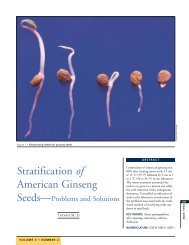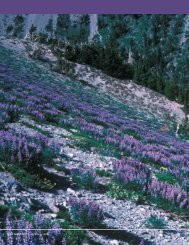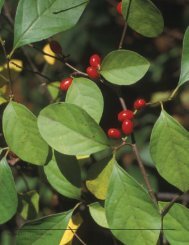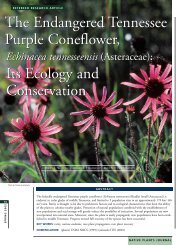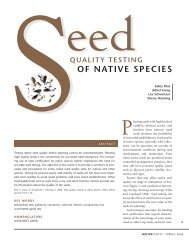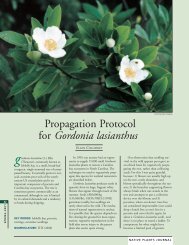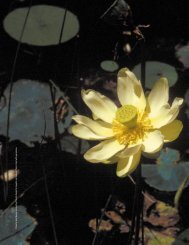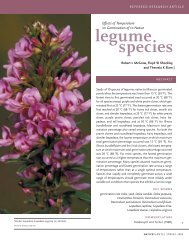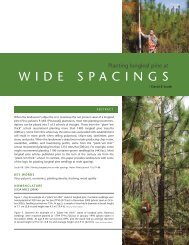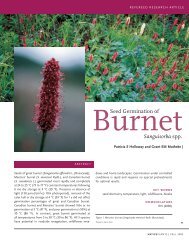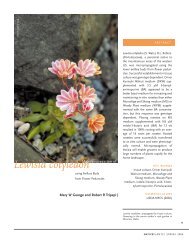Propagation Protocol for Meadow Beauty Rhexia virginica L ...
Propagation Protocol for Meadow Beauty Rhexia virginica L ...
Propagation Protocol for Meadow Beauty Rhexia virginica L ...
- No tags were found...
You also want an ePaper? Increase the reach of your titles
YUMPU automatically turns print PDFs into web optimized ePapers that Google loves.
118NATIVEPLANTS | SUMMER 2005
<strong>Meadow</strong>PROPAGATIONPROTOCOL FOR<strong>Beauty</strong><strong>Rhexia</strong> <strong>virginica</strong> L. (Melastomataceae)| Alessandro ChiariKEY WORDSwetland, Brooklyn Botanic GardenNOMENCLATUREUSDA NRCS (2004)<strong>Rhexia</strong> <strong>virginica</strong> L. belongs to the Melastomataceae, a group of about 200 genera primarilydistributed in tropical and subtropical regions. The genus <strong>Rhexia</strong> includes 11species of perennial herbs mostly found on wet acidic soils in the southeastern US;<strong>Rhexia</strong> mariana L. and R. <strong>virginica</strong> are the only 2 species found in the northeasternUS with R. <strong>virginica</strong> reaching southeastern Canada (Wurdack and Kral 1982).Commonly called meadow beauty, R. <strong>virginica</strong> is considered an obligate wetland plantin the northeastern US and a facultative wetland plant in the southeastern US, and it has<strong>Meadow</strong> beauty, <strong>Rhexia</strong> <strong>virginica</strong> L. (Melastomataceae)Photo by Joseph G Strauch Jr119NATIVEPLANTS | SUMMER 2005
120reached the status of threatened species inIowa and Vermont (USDA 2004). Thespecies can be found on wet sand, peat,and gravel along shores and ditches in fullsun or partial shade. It grows 40 to 50 cm(15.6 to 19.5 in) tall and produces showyflowers each with 4 pink-purple petals and8 bright yellow stamens. Flowers appear inJuly to September, measure 3 to 4 cm (1 to1.5 in) across, and are arranged in simpleor compound dichasia. Flowers last only aday and are buzz-pollinated. The anthersopen through minute pores, and pollenextraction can be achieved only with highfrequency vibrations such as those producedby buzzing insects such as beesand bumblebees (Larson and Barrett1999). In a study conducted on populationsof R. <strong>virginica</strong> in Ontario, Canada,they concluded that low plant fertilitywas a consequence of low rate of pollenremoval. Furthermore, the low level ofpollen removal was found to be causedby the particular morphology of theanther and the low frequency of pollinatorvisits per flower.The fruit of meadow beauty is a capsulethat ripens in late summer. Seeds are verysmall. <strong>Rhexia</strong> <strong>virginica</strong> can reproduce vegetativelythrough tuberous roots producedearly in the spring. Posluszny and others(1984) studied populations of R. <strong>virginica</strong>in Ontario and observed that the tuberousroots cannot survive in the soil <strong>for</strong> morethan a season. The authors concluded thatthis might be a reason <strong>for</strong> the rarity of thisspecies in Ontario.<strong>Meadow</strong> beauty, although still rare inAmerican gardens, has successfully beenput into cultivation, primarily in bog gardensand occasionally in perennial borderswhere it can reseed and be propagated byseparation of the tuberous roots (Cullina2000). The native flora garden at BrooklynBotanic Garden features a collection ofnative plants displayed in natural groupingsthat reflect the plant communitiesfound within 160 km (100 m) of New YorkCity.What I report here is how R. <strong>virginica</strong>was propagated from seeds and grown inthe nursery <strong>for</strong> its introduction into BrooklynBotanic Garden living plant collections.SEED COLLECTIONThe fruit of <strong>Rhexia</strong> <strong>virginica</strong> is a capsulethat remains enclosed within an urnshapedhypanthium, limiting seed dispersal.This facilitates seed collection becausemost of the seeds will not be shed whenthe capsule ripens. Capsules can be collectedin mid- to late September. Seeds canbe extracted as follows: turn the capsuleupside down, with its opening facingdownward, gently squeeze the capsule, androll it between the fingers; this action willtear the thin hypanthium and allow theseeds to fall. Seeds are very small and lightbrown in color.PROPAGATION<strong>Meadow</strong> beauty can be grown successfullyin containers provided the mediumis kept moist. If a warm greenhouse isavailable, seeds can be sown in late winterinto seed pans or small containersusing an ordinary germination mix withfine textures. Do not cover the smallseeds. It’s important to keep the mediumevenly moist during the germinationperiod. Seeds can also be surface sown inwinter in a cold frame following thestandard procedures <strong>for</strong> cold moiststratified seeds. After the pre-treatment,seeds will germinate in 2 to 3 wk at 21 °C(70 °F). Seedlings can be pricked outinto 5-cm (2-in) containers with amedium made of 1 part coarse sand and 3parts Sunshine 910 (Sun Gro Horticulture,Canada Ltd), a medium that contains40% to 50% composted pine bark and astarter dose of fertilizer. When plants outgrowthe small pots, they are repotted intoa 1-l (0.25-gal) container filled with thesame mix. The medium should always bemoist. Plants can be grown outside undera 40% shade covering. This will preventthe soil from drying out too quickly butwill still provide enough sunlight <strong>for</strong> plantgrowth. One summer application of20N:10P 2 O 5 :20K 2 O fertilizer at 240 ppmN is enough to support plant growth. Ifthe medium doesn’t contain a starter doseof fertilizer, 2 applications might be necessary.Under these conditions plants willflower in their first year of growth, about22 to 24 wk after sowing.SUMMARY<strong>Meadow</strong> beauty has very interesting ornamentalfeatures: its delicate showy flowersin the summer and its vibrant red fall colormake this plant a perfect candidate <strong>for</strong> themoist, sunny locations in the Americangarden. It’s easy to propagate and grow in anursery provided adequate moisture levelsare maintained in growing medium.REFERENCESCullina W. 2000. The New England WildFlower Society guide to growing andpropagating wildflowers of the UnitedStates and Canada. Boston (MA):Houghton Mifflin Company. 384 p.Larson BMH, Barrett SCH. 1999. The ecologyof pollen limitation in buzz-pollinated<strong>Rhexia</strong> <strong>virginica</strong> (Melastomataceae). Journalof Ecology 87:371–381.Posluszny U, Sharp MJ, Keddy PA. 1984. Vegetativepropagation in <strong>Rhexia</strong> <strong>virginica</strong>(Melastomataceae): some morphologicaland ecological considerations. CanadianJournal of Botany 62:2118–2121.[USDA NRCS] USDA Natural Resources ConservationService. 2004. The PLANTS database,version 3.5. URL: http://plants.usda.gov. BatonRouge (LA): National Plant Data Center.Wurdack JJ, Kral R. 1982. The genera of Melastomataceaein the southeastern United States.Journal of the Arnold Arboretum 63:429–439.AUTHOR INFORMATIONAlessandro ChiariPlant PropagatorBrooklyn Botanic Garden1000 Washington AvenueBrooklyn NY 11225-1099alessandrochiari@bbg.orgNATIVEPLANTS | SUMMER 2005PROPAGATION PROTOCOL FOR MEADOW BEAUTY



